Canon EOS 5D Mark II Review
Review Date: December 4th 2008
Author: Mark Goldstein
Leave a comment about this Review
|
Introduction
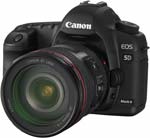
Announced just over 3 years since its popular predecessor, the long-awaited Canon EOS 5D Mark II digital SLR camera has finally arrived. The original EOS 5D was the first full-frame 35mm DSLR available at an "affordable" price point, appealing to the enthusiast and professional user looking to maintain the true focal length of their lenses. Now the 5D Mark II is here, and although it looks very similar from the outside, there have been some major improvements on the inside. The twin headline features are the 21.1 megapixel, full-frame CMOS sensor, and the ability to record video at 1080p high-definition. Yes, you read that correctly - the Canon 5D Mark II can shoot HD movies, making it the second DSLR after the Nikon D90 to offer video recording (the D90 records at the lower resolution of 720p). Other new and improved features include an expanded ISO range of 50-25600, surpassing the original 5D (50-3200) and matching the likes of the Nikon D3 and D700, a larger 3 inch LCD screen with 920k dots and Live View, built-in dust prevention system and continuous shooting at 3.9 frames per second. Slightly cheaper than the original 5D on launch (�2299 vs �2539 body only), is the new Canon EOS 5D Mark II a worthy successor to the best-selling original model, and can it compete with its main rivals, the Nikon D700 and Sony A900?
Compare Prices
Support PhotographyBLOG: Buy the Canon EOS 5D Mark II from one of our affiliate retailers:Ease of Use
"It if ain't broke, don't fix" it seems to have been the key aim of the Canon engineering team when designing the 5D Mark II. It's outwardly almost identical to its predecessor, sharing exactly the same dimensions (152 x 113.5 x 75mm), and same weight (810g), making it very slightly bigger and heavier than the next Canon model down the range, the EOS 50D. The 5D Mark II has the same magnesium alloy body as the original 5D Mark I, which should make it more durable in the longer term than plastic-bodied cameras, but it doesn't add any serious level of weather-proofing. Other than the larger LCD screen, slightly chunkier handgrip, bigger top LCD display, and tweaked control layout, you'd be hard-pushed to tell the difference between the Mark II and Mark I if they were put side by side with the name-badge blanked out. The most serious design flaw on the 5D Mark II is the rubber cover for the extension system terminal on the bottom of the camera, which will take you about five minutes to lose as it's completely unsecured.
There's a textured area on both the deep hand-grip and around the thumb-rest on the rear of the camera, and unlike the cheaper 450D and 1000D models, the 5D Mark II is perfect for everyone with normal to large-sized hands. Like other semi-pro cameras, the Canon EOS 5D Mark II offers two control wheels; a small one on the top of the handgrip, and a large, spinning dial on the back of the camera. This rear 'quick control dial' is characteristic of all high-end Canon EOS cameras. It's a bit of an acquired taste compared to more conventional control dials, but you quickly get used to it and it is easy to 'spin'. The power switch has a third position which activates this dial, and you can then use it to apply rapid exposure adjustments.
The quick control dial does take up the space where you'd normally expect to find a four-way controller, which means that for menu navigation Canon has had to incorporate an additional small joystick on the back of the camera. This joystick works well enough, but it's not as positive or as easy to use as a conventional four-way controller. On the 5D Mark II, Canon has extended the joystick's capabilities; pressing it in opens the new Quick Control screen. Depending on which shooting mode you're using, this lets you set various parameters via the LCD screen, using the joystick to move around the various options. First featured on the EOS 50D and similar to the system that Sony Alpha DSLRs have used for a while, the Quick Control screen is particularly well-suited to beginners and tripod work.
On top of the Canon EOS 5D Mark II, positioned above the large monochrome status LCD display, are three buttons, each of which has two functions. You press a button and then turn either the top dial or the rear dial to change the corresponding setting. It does take a little while to memorise which button does what, and which dial you need to turn, not helped by the fact that when compared to the original 5D, the same six settings have been moved between buttons, which is will initially confuse upgraders. The 5D Mark II now also shows the settings on the main LCD screen as well as the status LCD. There's also a smaller fourth button which activates the status LCD display light so that you can use it in the dark.
There are two LCD displays on this camera; the 3-inch colour LCD on the rear and the smaller status panel on the top. On cheaper DSLR cameras, the LCD on the rear usually has to do both jobs, but on this model all the camera settings are visible from above on the smaller panel. This makes the Canon EOS 5D Mark II quicker to use, and also helps to extend the battery life. The main LCD screen has been significantly improved, now offering a fantastic VGA resolution with 920K dots, so you may find yourself using it more often than you thought. Importantly it brings the 5D Mark II in line with its main competitors, and it also allows you to judge the critical sharpness of your photos using the LCD screen, which has been a long-standing issue on Canon's entry- and mid-range DSLRs, including the original 5D. The viefinder has also been upgraded, now offering an improved 98% coverage to its predecessor�s 96%, better than the D700 (95%) but not quite as good as the Sony A900 (100%).
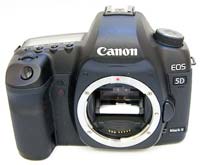 |
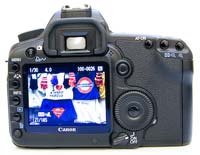 |
| Front | Rear |
Like most DSLRs aimed at prosumers, the EOS 5D Mark II offers all the usual serious manual and semi-automatic shooting modes for users who want more advanced exposure control, via a chunky and positive dial on the top-left of the camera body. Canon refers to these advanced operations as the 'creative zone' and provides all the normal settings including Program, Aperture and Shutter Priority and the full manual mode. There are two auto shooting modes aimed at beginners - Full Auto (the green mode) and Creative Auto (CA). The latter was first featured on the cheaper 50D model, and is targeted at beginners who have grown out of using the Full Auto mode, allowing you to change a few key settings using the LCD screen, with a simple slider system for changing the aperture and exposure compensation, or Background and Exposure as the camera refers to them.
Once the EOS 5D Mark II is in the 'creative zone', users can adjust the ISO setting into one of ten positions from 50 to 25600 (you need to to enable the ISO 50, 12800 and 25600 modes via the "ISO expansion" custom function option). This massive ISO range allows you to shoot in almost any lighting conditions without having to resort to using flash, which is good news as the 5D Mark II doesn't actually have a built-in pop-up flash (you'll need to budget for an external flashgun). The EOS 5D Mark II offers a range of three Auto focus modes (One Shot, AI Focus and AI Servo), and there are six preset, auto, kelvin and custom white balance options. The viewfinder displays all key exposure information including ISO speed, and the 5D Mark II uses exactly the same 9-point auto-focus system with 6 Assist AF points as the 5D. There are four metering modes including a 4% Spot metering mode, useful in tricky lighting conditions as an alternative to the excellent and consistent Evaluative metering system.
The menu system is now the same as on most EOS cameras, utilising a simplified tab structure that does away completely with scrolling, and is a big improvement on the original 5D's menu. There are 9 colour-coded horizontal tabs and up to 7 options in each one, providing quick and easy access to the various options. You can even setup your own customised menu page for instant access to frequently used settings via the My Menu tab. Only the complex Custom Functions menu detracts a little from the overall usability. The documentation that comes with the 5D Mark II is very clear, as it is with all Canon cameras. You get a detailed manual in English throughout and you'll find everything you need to know about the camera's operation in here, without the need to search through the supplied CDs for an 'electronic' manual.
I tested the EOS 5D Mark II with the popular EF 24-105mm f/4L IS lens, which is offered as a kit lens in some regions. This combination offered fast, positive autofocus, which can track moving subjects very well and which is also near-silent, and I'd recommend that you buy this kit if you're buying into the Canon system for the first time. The 24-105mm lens also crucially features image stabilisation. This is important for Canon, as the Sony A900 offers image stabilisation that's built-in to the camera body. The difference between Canon (and Nikon) and the other manufacturers is that Sony (plus Olympus and Pentax) have opted for stabilisation via the camera body, rather than the lens, which therefore works with their entire range of lenses. Canon's system is obviously limited by which lenses you choose, but it does offer the slight advantage of showing the stabilising effect through the viewfinder. Canon and Nikon also claim that a lens-based anti-shake system is inherently better too, but the jury's out on that one.
The EOS 5D Mark II is the second Canon DSLR to feature the new DIGIC 4 processor, which produces noticeably faster image processing, start-up and image review times than the 3-year old 5D (as you'd expect), and better noise reduction in high-ISO images (jump to the Image Quality page for ISO samples). DIGIC 4 also allows the 5D Mark II to shoot a little faster than the previous 5D model, obtaining a speed of 3.9fps for up to 78 full-sized JPEGs or 13 RAW images (the 5D could shoot at 3fps). If you use a UDMA (Ultra Direct Memory Access) Compact Flash memory card with the 5D Mark II, the number of JPEGs increases to 310 images (no increase in the actual burst speed, or the number of RAW files), and it supports transfer speeds up to 133 MB/sec.
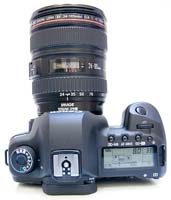 |
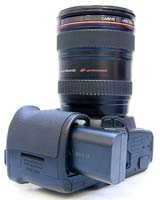 |
| Top | Battery Compartment |
The 5D Mark II has a very similar Live View system to the 50D and 450D, additionally offering a new Live AF with Face Detection mode. If you're new to DSLRs and don't understand the terminology, basically Live View allows you to view the scene in front of you live on the LCD screen, rather than through the traditional optical viewfinder. This is an obvious attraction for compact camera users, who are familiar with holding the camera at arm's length and composing via the LCD screen. It's also appealing to macro shooters, for example, as it's often easier to view the screen than look through the viewfinder when the camera is mounted on a tripod at an awkward angle.
Live View is annoyingly difficult to actually turn on, as Canon have inexplicably buried it deep within the menu system. Once enabled, Live View is activated by pressing the Print button on the rear of the camera to the left of the viewfinder. A grid line display and very useful live histogram can be enabled to help with composition and exposure, and you can zoom in by up to 10x magnification of the image displayed on the LCD screen. Focusing is achieved via the new AF-On Lock button, rather than half-pressing the shutter-button. Live View can also be controlled remotely using the supplied EOS utility software, which allows you to adjust settings and capture the image from a PC.
So who does the EOS 5D Mark II's Live View mode most appeal to? Well, it attempts to satisfy both the consumer and more technical user, with three types of focusing system on offer. The first, Quick AF, works by physically flipping the camera mirror to engage the auto-focus sensor, which then momentarily blanks the LCD screen and causes a physical sound, before the image is displayed after about 1 second. The other methods, Live AF and Live AF with Face Detection, use an image contrast auto-focus system, much like that used by point-and shoot compacts, the main benefits being the complete lack of noise during operation, and no LCD blackout. Unfortunately these are much slower than the Quick AF mode, taking over 3 seconds to focus on a clearly-defined subject in bright light, which I think will put off most users that are attracted by the promised point-and-shoot experience. On a more positive note, you can move the AF point around the screen, and the 5D Mark II successfully detected faces in most situations.
Live View is also used for the feature that has arguably generated the most interest in the Canon EOS 5D Mark II: its movie mode. This is the second DSLR camera to shoot video, and the first that supports full 1080p HD quality (the Nikon D90 records lower-resolution 720p video). The 5D Mark II records high-definition, wide-screen video in 1920 x 1080 pixel resolution, at a frame rate of 30fps, in MOV format using the H.264 codec. The maximum size of a single video clip is either 4 gigabytes or one second below 30 minutes, much longer than the D90's 5 minute limit. You can also take either single or continuous stills during recording, with video capture continuing after the final still frame has been taken. Audio is recorded in linear PCM format without any compression. There's a built-in microphone on the front of the camera for mono recording, and also a socket on the side for connecting an external stereo microphone. It also has an HDMI port for playing back 1920 x 1080 still images on a HD TV. It uses the industry-standard HDMI mini-out connection, but note that you'll need to purchase a suitable cable separately. You can also still connect the 5D Mark II to a standard TV set via NTSC/PAL. By offering video capture in a DSLR, Canon has made it possible for filmmakers to play with depth of field the way they never could, taking advantage of the relatively big 35mm sensor and the wide assortment of Canon lenses.
There are, however, some notable drawbacks to the Canon EOS 5D Mark II's video mode. Immediately apparent is the complete lack of a dedicated video button. On the D90, shooting video is as easy as pressing the correct button on the back of the camera. On the 5D Mark II, you have to set the correct options in the Live View menu, then press the Print button on the rear of the camera, then AF-On to set focus, then the Set button to actually start recording. Although you can autofocus during movie recording, the camera uses the painfully slow contrast-AF mode, and even the user guide warns against trying to auto-focus "since it might momentarily throw the focus way off or change the exposure". Focusing manually is a much better idea, although most AF lenses have MF rings with very little 'travel' between their close-focus point and infinity (the EF 24-105mm f/4L IS is quite good in this regard), and in a quiet environment it's also possible to hear the sound of the focusing ring.
You can't set the aperture from the camera in movie mode, so you will want to use lenses that have an aperture ring or just stick with your chosen aperture throughout the movie. The shutter speed cannot be set by the user in movie mode either, so you will have to rely on the camera's auto-exposure system while filming, although exposure compensation and AE-Lock can, thankfully, both be used. You can take a single/sequence of still shots whilst shooting video, but this causes a 1 second delay which you'll need to edit out later. Handholding the EOS 5D Mark II and shooting video is very difficult, with the DSLR form factor not lending itself well to controlled shooting at arm's length. It's a much better idea to mount the camera on a dedicated video tripod. Having said all that, I've no doubt that experienced videographers will be writing our their cheques for the 5D Mark II right now, having seen all that glamorous Vincent Laforet footage. More casual users hoping to grab some quality footage of the kids may be put off by the inherent difficulties of shooting video using the relatively alien SLR format.
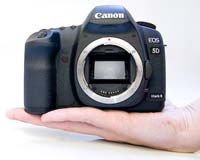 |
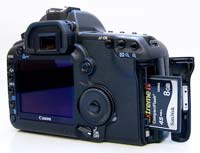 |
| Front | Memory Card Slot |
The EOS 5D Mark II now implements the same dust-removal technology as the EOS 50D, where the sensor is shaken briefly at high frequency to dislodge any dust particles from its surface. This could delay the need for manual sensor cleaning, perhaps indefinitely, but it won't be able to remove 'sticky' deposits like salt spray, pollen or the smears left behind by careless sensor cleaning or the wrong kind of solvent. The 5D Mark II also inherits the internal Dust Delete Data system from the 50D, which can map the position of visible dust on the sensor. This can then be deleted automatically after the shoot with the supplied Digital Photo Professional software.
Peripheral Illumination Correction is a new feature that's actually a lot simpler that it initially sounds. Basically it corrects the unwanted effects of vignetting, typically seen in wide-angle photos in the corners of the frame. The 5D Mark II contains a database of correction data for 26 Canon lenses and, if Peripheral Illumination Correction is enabled, automatically applies it to JPEG images. For RAW images the correction is applied later in the Digital Photo Professional software. Up to 40 lenses can be programmed into the 5D Mark II, with over 80 currently available to choose from. Peripheral Illumination Correction is a useful and effective addition, particularly for JPEG shooters, and can safely be left turned on all of the time.
Even more useful, especially if you have a number of older lenses, is the AF Microadjustment feature that has trickled down from the pro Canon EOS-1D Mark III. Very similar to the Pentax K20D's AF Adjustment custom function, it allows you to alter the focus of each lens, then use a focusing target to test if the lens focuses correctly, and if it doesn't, alter it slightly using the AF Adjustment option, then test again until perfect focus is achieved. With most other DSLR systems you'd have to send the camera and lens off for calibration (and maybe even have to pay for it), but with the 5D Mark II, you can calibrate all of your lenses in the comfort of your own home (up to 20 lenses can be stored in the camera).
Once you have captured a photo, the Canon EOS 5D Mark II has an average range of options for playing, reviewing and managing your images. More information about a captured image can be seen on the LCD by pressing the Info button, which brings up a brightness image histogram and all the shooting Exif data, including shutter speed and the time and date it was captured, with a second press displaying an additional RGB histogram. Highlight Alert and AF Point Display can also be turned on via the Playback menu. It is simple to get a closer look at an image as you can zoom in up to 15 times, and it is also possible to view pictures in a set of nine contact sheet. You can also delete an image, rotate an image, view a slideshow, protect images so that they cannot be deleted, and set various printing options. Unlike some competitors, there are no digital styles or effects that can be applied to an image after it has been taken - the more subtle Picture Styles are the only way of tweaking your JPEGs in-camera, before they are captured.
The Canon EOS 5D Mark II's software suite is very good. Admittedly, photographers who've graduated to a camera like this one will almost certainly have chosen image browsing and editing software already, so they won't need the basic image browsing program included here, but there's more than that. You also get Canon's simple but effective PhotoStitch application for making panoramic shots, a utility for using the 5D Mark II remotely (while tethered to a PC) and Canon's Digital Photo Professional application for converting RAW files. This is a big bonus, because other makers don't always include such good RAW conversion software. Digital Photo Professional certainly isn't the best RAW converter on the market, but importantly does mimic the camera's Picture Styles 'retrospectively'. In addition the supplied Picture Style Editor software can be used to create custom Picture Styles on your computer instead of in-camera.
In summary, the Canon EOS 5D Mark II is a very well-made camera with a no-fuss design that's aimed firmly at serious photographers. At first glance very similar to the previous 5D Mark I model, the new EOS 5D Mark II offers some important feature upgrades and some subtle but effective handling improvements.
|
![]() PhotographyBLOG
is a member of the DIWA
organisation. Our test results for the Canon EOS 5D Mark II have been submitted to DIWA
for comparison with test results for different samples of
the same camera model supplied by other DIWA
member sites.
PhotographyBLOG
is a member of the DIWA
organisation. Our test results for the Canon EOS 5D Mark II have been submitted to DIWA
for comparison with test results for different samples of
the same camera model supplied by other DIWA
member sites.
